Above: Pictographs in Canyon Lands National Park, Utah, US, dated 1275 CE, depict Cloud Women with a Sun Youth in the centre. He climbs up into the sky and arouses the Cloud Women from the four directions to gather together and produce rain. Photo: Craig Law.
Prehistoric Art of the Colorado Plateau: It’s All About Clouds!
By Carol Patterson, PhD
Rain is of dire importance for survival in the southwest United States. Prehistoric people gave voice to cloud-spirits through ritual prayers and rain ceremonies. They viewed their world as animate, and they engraved or painted imitative rain making ceremonies into rocks and artefacts to motivate cloud behaviour. Carol Patterson (Member 59,026) has compared extensive documentation of rock art and artefacts from the Colorado Plateau region of Utah, Colorado, New Mexico, and Arizona to actual cloud formations and found a common theme of clouds as animate rain bringers, or ‘cloud beings’. Elements of the pictographs (rock paintings), petroglyphs (rock carvings), and artefacts of the Zuni, Keres, and Apache are mirrored in the emergence stories that frame the different worldviews of each group, and clouds for these agricultural groups seem to have been a dominant concern.
Cloud Beings
I first got the idea that clouds were represented in rock art when I saw a meteorologist give a presentation to the Utah Rock Art Research Association in the 1980s. He proposed the theory that Barrier Canyon Style pictographs in Utah represented clouds. He showed examples of various cloud formations and their similarity to floating anthropomorphic forms in the pictographs, including the popular well-known site, known as the Great Gallery in Utah’s Canyon Lands National Park.
With that idea in the back of my mind, I’ve also learned that Native people strongly believe ‘All things are sentient. All things have a spirit.’ Especially clouds, which the Hopi and other Pueblo Indians address as Katsina, or ‘rain-bringers’. The Pueblo people of the Southwest perform masked dances impersonating these rain-bringers. The Acoma Pueblo people call their cloud beings Shiwanna, and the Zuni Indians call theirs the U’wanami, or ‘rain makers’. The Katsina dances that tourists come to see at Hopi are masked dancers impersonating the cloud beings. They are called the Longhair Katsinas.
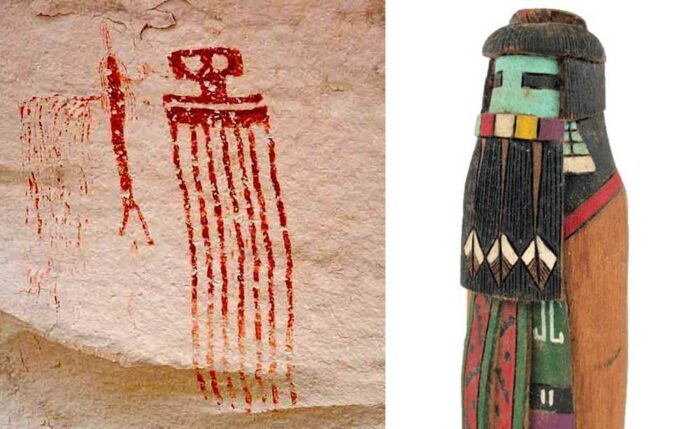
Left: Pictograph of a cloud being and priest with prayer feather, dated 600-1250 CE, from San Raphael Swell, Utah. Right: Hopi Angak’china, or Longhair Katsina doll. The long hair down the back and the front represents rain falling. Prayer feathers are attached to the doll’s ‘rain beard’. Photo: David Manley.
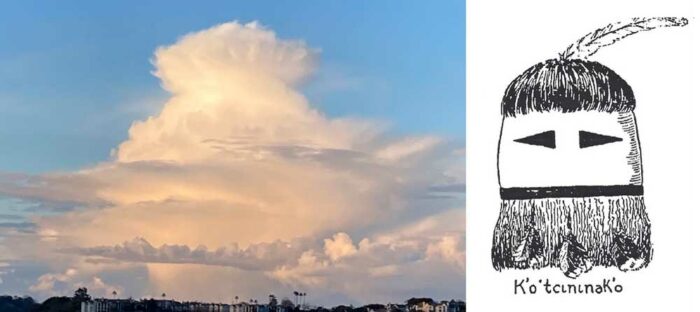
Left: Cumulonimbus storm cloud spotted over San Rafael, CA, US by Candace Key (Member 25,435). Right: A Katsina mask of a storm cloud. The mask’s feather corresponds to the top of the cloud. Its white mask corresponds to the face of the cloud. The band below the mask face suggests the dark cloud bases, while its beard corresponds to the dark rain falling. Very early versions of cloud beings appear in southwest Utah at ancestral sites of the Pueblo Indians. Drawing: Leslie White (1932).
Imitative Magic
Rain making ceremonies are sometimes referred to as imitative magic. It is thought that by re-enacting ‘rain making’ with water, smoke and sound effects, the clouds will participate by producing rain. Examples include rolling polished round stones called ‘thunder rocks’ across the floor to ‘call the thunder’ and imitate the sound of thunder, and blowing tobacco smoke in six directions imitating the rain maker’s misty breath and sprinkling sacred water to induce rain to fall [Bunzel 1932, 492].
Pictographs in San Rafael Swell, Utah, shown below, depict such a rain-bringing ceremony. The gestures combined with symbols of rain and moisture animate the imitative rain making ceremony. The cloud being is pictured on the far right of the rocks hiding under the sky, which is represented by a line arching over its head. The same being is shown larger on the left of the rock as it approaches the rain priest who is conducting a rain ceremony to call the cloud out. The drawing of this pictograph shows more detail of the rain-making ceremony. The slender rain priest has a tall prayer feather from his head. He is issuing smoke from his mouth that he blows in front and in behind his head. From his arm he is sprinkling sacred water to simulate rain. In his left hand he raises a prayer feather that signals his intentions of praying for rain. The large cloud-being is poised slightly toward him with large open eyes in full attention. His body incorporates the symbol of rain coming down to the ground.
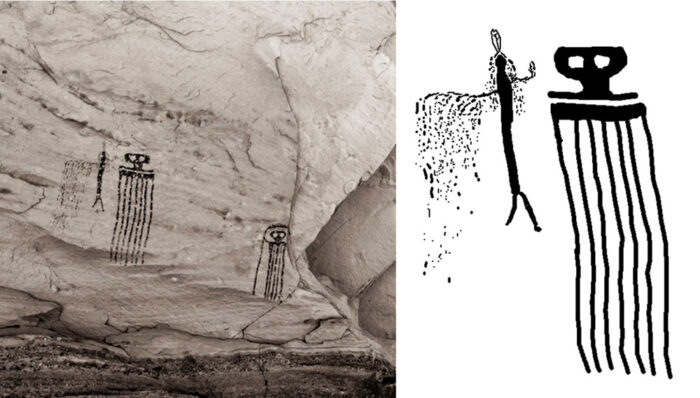
Left: Pictographs in San Rafael Swell, Utah (600-1250 CE) depict an imitative ritual of a rain bringing ceremony in one simple composition. Right: This drawing shows detail of the rain priest being observed by the cloud being. Photo: Dave Manley. Drawing: Carol Patterson.
Rain or Fake Rain?
Another variant of a cloud being resembles the profile of a cloudburst with heavy rain. The feet are flat, level with the ground and the rain reaches the ground like a skirt. The petroglyph below located in Indian Creek, near Moab, Utah shows a shower between the cloud being’s legs. Its gesture of arms outstretched and arched is a symbol that represents the sky. Cumulonimbus storm clouds, with their broad upper canopy, known as an incus, and their heavy showers falling on a localised area have a similar appearance, especially when viewed from a distance like the Cumulonimbus beneath, spotted over Bluff, Utah by Paul Martini (Member 27,060).

This petroglyph in Indian Creek, Utah, dated 600-1250 CE, shows a cloud being with a cloudburst of rain reaching the ground. The gesture of arms outstretched and arched like this represents the sky. Photo and drawing: Carol Patterson.
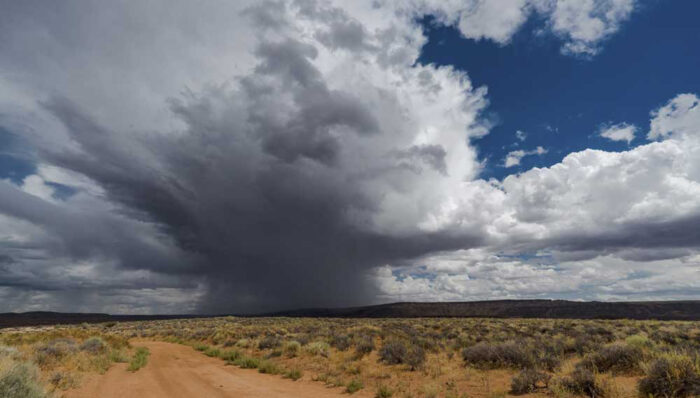
A localised shower falling from a Cumulonimbus capillatus storm cloud spotted over Bluff, Utah, US by Paul Martini (Member 27,060).
By contrast, a cloud with streaks of virga is illustrated by the petroglyph below, also in Indian Creek, Utah. Here, the arm gestures suggest a downward movement, but the flared fingers of the hands signal ‘caution’, or ‘halt’. Virga is precipitation that evaporates away before reaching the ground. This cloud being has little antennae pointed upwards, a gesture of ‘pay attention’. The petroglyph’s combination of gestures cleverly portrays a warning of virga’s empty promise of rain, which never actually reaches the ground.

Petroglyph in Indian Creek, Utah showing a cloud being signalling caution, with streaks of virga, which are showers that evaporate before touching down. The ground is pecked-in solid, but there is daylight between the cloud’s body and the ground. Dots rather than lines indicate virga instead of heavy rain. Photo and drawing: Carol Patterson.
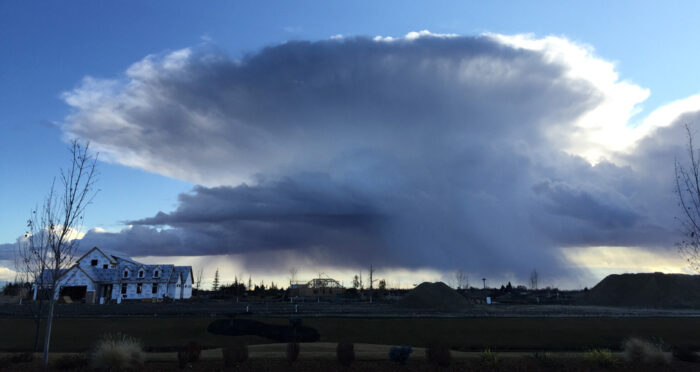
Virga falling from a Cumulonimbus over Eagle, Idaho, US by Suzan Bunting (Member 51,399).
Weather Animals
The cloud-being in the pictograph below in Dolores River, Colorado includes the symbols of a snake, which is associated with lightning, and a hummingbird, which is believed to be a messenger with prayers to bring rain. The outstretched arms of the cloud being have rain as well as its full body consisting of rain. The lightning snake under its arm is stimulating the rain to fall. It looks like a storm cloud with lightning that has a heavy downpour in one region and lighter rain falling in others.
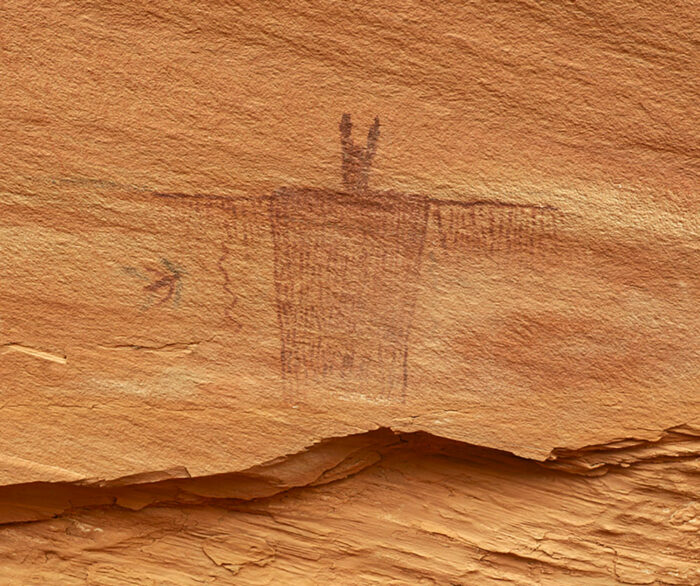
Pictograph of a cloud being in Dolores River near Naturita, Colorado, which includes a snake to stimulate lightning and a bird messenger. Photo: Carol Patterson.
Lightning Feet
There are examples of cloud beings with lighting that have a very similar appearance to modern photographs of storm clouds that have captured lightning bolts. Clouds can seem to be standing on lightning feet, which look like plant roots going down into the ground. Pictographs of cloud beings with lightning feet are found at the eastern Utah rock-art sites Little Wild Horse Canyon, Buckhorn Wash, and Virgin Spring Canyon.
The actors in the Virgin Spring Canyon site below are imitative of rain-bringing ceremonies with all the necessary components needed to entice a cloud being to reciprocate their efforts of a successful rain ceremony. All are actively engaged with their individual powers to bring rain. Even their V-shaped feet are imitative of “standing in soft mud” [Martineau, 1973].

This ‘rain-bringer’ variation of a cloud being appears on the left of a pictograph panel in Virgin Spring Canyon, Emery County, Utah. The tall slender figure incorporates the symbols for ‘sky’ with its arms and rain coming down underneath, and lightning coming from its feet. It is accompanied to its right by one figure holding two long prayer wands. A second stands under a dark cloud with ‘thunder’ emanating from it. A third is sprinkling moisture from its hand and pees sacred water onto the ground. The fourth figure is carrying a dragonfly spewing moisture from its mouth. All four figures are sinking into wet mud. Their feet incorporate the symbol for ‘soft earth’. Photo: Dave Manley.

A drawing of the rain-bringer with lightning feet and attendant with long prayer wands, stepping in wet mud resulting from the rain. Drawing: Carol Patterson.
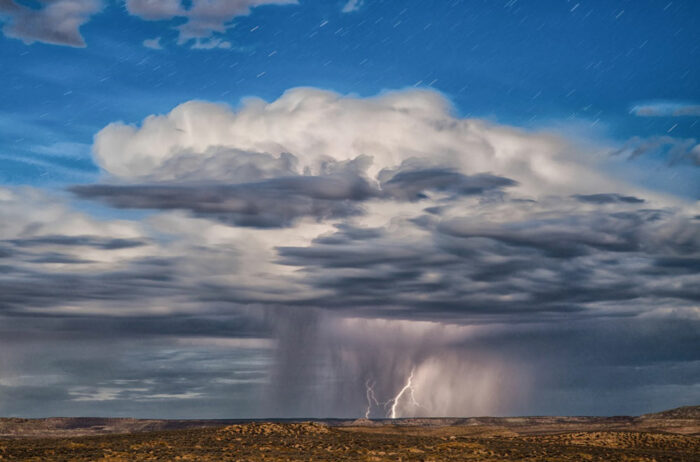
Cumulonimbus storm system – with lightning feet! – spotted over Bluff, Utah, US by Paul Martini (Member 27,060).
Rainbows Ladders
Clouds with rainbows are found throughout the Colorado Plateau. For the Pueblo cultures, rainbows are ladders that the Katsinas (rain bringers) use to climb down to the earth. The Pueblo people paint the four colours of the directions in a ladder motif across the face of their rain Katsina masks. Some use only black and white ladder motifs. The ladders accompanying the cloud beings, shown below, around India Creek, near Moab, Utah represent rainbows. The first of these may be depicting a cloud with virga, which are sometimes accompanied by rainbows.

This cloud being petroglyph in Indian Creek, Utah has a very sparse rain beard between its legs that does not touch the ground level where his feet are. It has a rainbow ladder hanging down from its belly. Rainbow ladders are used by Katsina spirit-beings that can travel down to earth and back up again. Photo and drawing: Carol Patterson.

A Cumulonimbus forming a rainbow in its shower, spotted over South Fork, Colorado, US by Cynthia Rutledge.
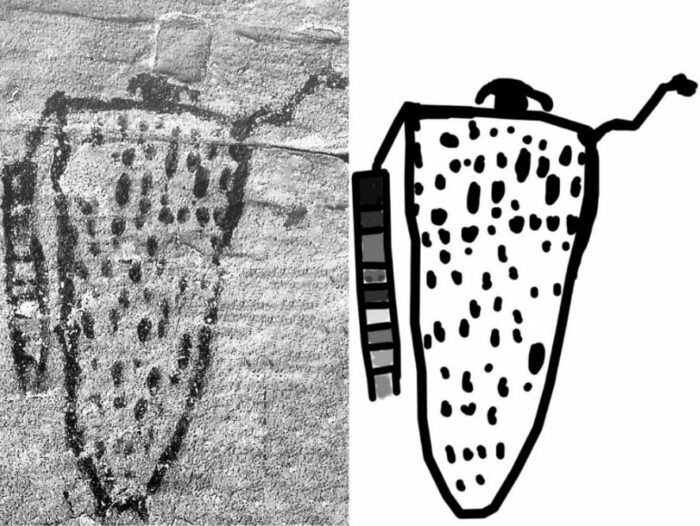
A cloud being pictograph in Indian Creek, Utah with light rain and holding a ladder, the symbol for a rainbow. Photo: Dave Manley. Drawing: Carol Patterson.

Cumulonimbus with virga and a rainbow spotted over Alamosa, Colorado, US by Heather Erdmann (Member 40,998).
Hail
The depiction of hail clouds is very rare in the rock art of the Colorado Plateau. This may be because hail is detrimental to gardens of agricultural groups like the Zuni and Keres. But it wouldn’t be an issue for the hunter/gatherer peoples. In fact, hail is beneficial for helping establish wild grasses, whose windblown seeds drift across the landscape ahead of a storm. Hail stones create tiny potholes in the soil leaving a small ball of frozen water to hydrate any seeds submerged by the impact.
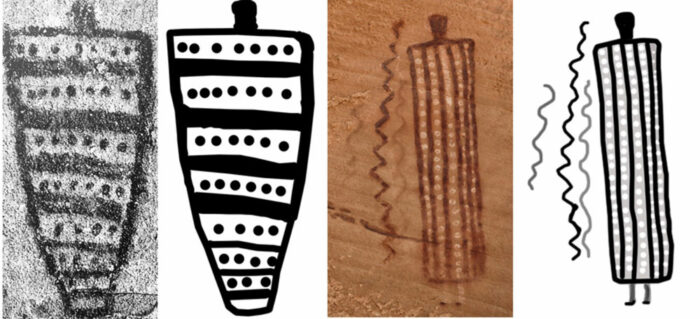
These pictographs from San Rafael Swell, Utah show cloud beings with lightning and hail, described by a Zuni informant as ‘ribbons of hail’ [Bunzel, 1932]. Hail is depicted by round rather large dots representing hail stones. Photos: Dave Manley. Drawings: Carol Patterson.
It’s All About Clouds!
We have seen through the ethnography and mythic text that clouds are rendered as animate beings in the rock art of the Colorado Plateau, with formal names and personalities rendered by the descriptions in the oral narratives of each cultural group. The cloud beings transmit their identity following the rules of style, body postures, and iconic idioms dictated long ago. Traditional narratives survive through time because they are formulated on cultural wisdom of the environment and a relationship based on reciprocity with the cloud beings.
The clouds are animate and created from the imagination according to separate cultural traditions. Each form is rooted in the mythic language of idioms and social imagery. Some are ‘cloud houses’, some are ‘sky beings’, some are ‘ancestral spirits’, some carry lightning sticks, some bring showers and others bring thunder, and they are all the rain-bringers we call clouds. Through the creation myths, many diagnostic elements can be identified in the prehistoric art of the American Southwest. The combination of spirit figures and canines is unique to the Jicarilla Apache emergence story. The story of the Koshari rain ceremony, drum and thunder rattle are unique to the Keres. The story of ancestor spirits as rain bringers is unique to the Zuni.
In the animate world, everything has a spirit and a personality. I’ve grown to love the ingenious ways of knowing clouds through these visual representations. The peoples lived by the natural laws of reciprocity requiring extraordinary dedication to their prayers and ceremonies, especially in their artistic renderings engraved or meticulously painted on the sandstone walls. Animated through spatial positioning and body postures, the rain ceremonies embedded in the rock faces of the Colorado Plateau offer us a fascinating glimpse into the cloud beings that existed in the minds of preliterate people.
References:
Bunzel, Ruth. 1932a. Zuni Katchinas. Forty-Seventh Annual report of the Bureau of American Ethnology Washington, DC: Smithsonian Institute.
Martineau, LaVan. 1973. The Rocks Begin to Speak. KC Publications, Las Vegas.
White, Leslie A. 1932. ‘The Pueblo of San Felipe.’ American Anthropological Association Memoirs 38.




Thank you so much for posting this piece. This was new information for me and I loved learning about the
cloud beings.